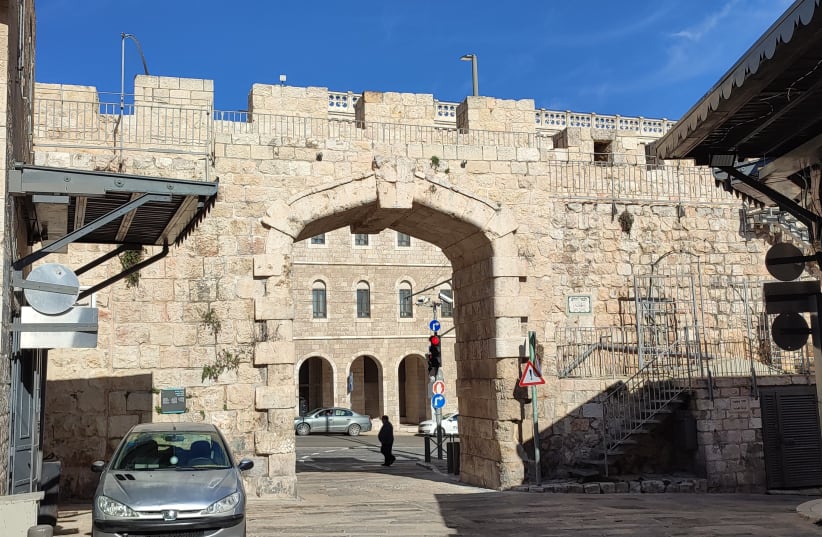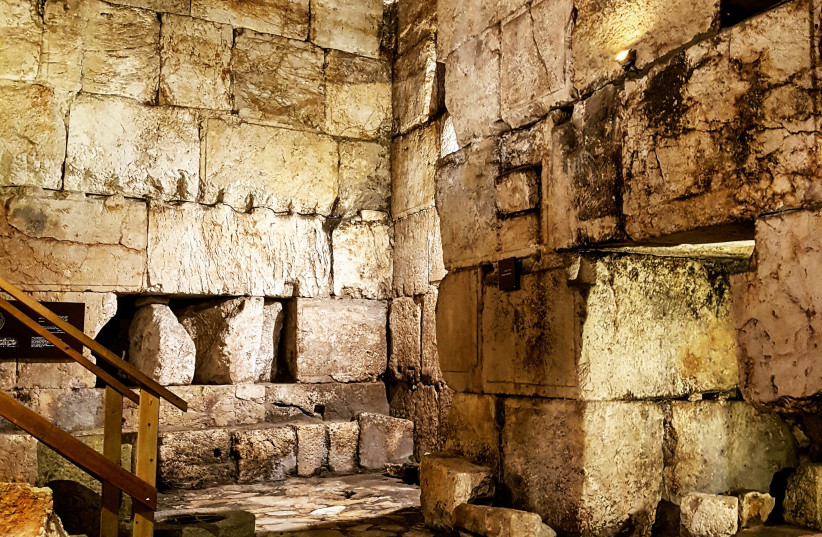A British author laments the state of affairs in the Old City under Israeli rule.
Does he have a point?
Biographies tend to tell us as much about their subjects as the priorities of their authors in illuminating those subjects, and Matthew Teller’s The Nine Quarters of Jerusalem: A New Biography of the Old City is no exception. The British writer, a journalist and travel-book author, poses a pertinent question and takes it from there.
How is it, Teller ponders, that on all modern maps, the Old City has been depicted with four distinct if uneven quarters within its walls? This division of the premises, he reminds us, is a peculiar contrivance that has borne little resemblance to realities on the ground, where faiths and ethnicities have for centuries been entangled and entwined in ways that belied so neat a demarcation.
The problem started centuries ago when in creating stylized and symbolically symmetrical maps for Christian pilgrims, European cartographers imposed their own religious and aesthetic preferences onto the Old City. Their aim was to create order out of disorder, which entailed demarcating distinct areas where none might have existed.
Observing these maps in chronological order can make for a dizzying experience, as the contours of the city sections shifted this way or that, overlapped here and there, or even disappeared entirely only to reappear elsewhere. It didn’t help matters that many foreign cartographers had never been to Jerusalem, and so based their schemas not on detailed observations but on earlier maps and the potentially suspect accounts of travelers.
Then, in the early 1840s, along came Edward Aldrich and Julian Symonds, two British military engineers who conducted a detailed survey of Palestine. In the process, they identified four quarters within Jerusalem’s walled city: Christian, Armenian, Muslim and Jewish. “No map had shown this before,” the author laments. “Every map has shown it since.”
This artificial quartering of the city, Teller argues, denied Jerusalem’s reality as an essentially “Muslim city.” His assertion, however, flies in the face of demographic reality, because by 1844 Jews were in the majority among the residents of Jerusalem (then a town of 15,500 inhabitants), numbering as they did almost twice the number of Muslims and Christians together.
The new British overlords of the city did not stop there, Teller avers. During their three-decade rule after 1917, they stipulated — in a policy later adopted by the State of Israel — that for the sake of fidelity to the city’s ancient vintage, all new buildings be clad in the pale limestone and dolomite that had been quarried locally for millennia to construct landmarks like the retaining wall of King Herod’s Temple compound, of which the Kotel was one part. We might consider this decision by the British to have been an inspired one, for it would give Jerusalem a salient aesthetic and spare the city from becoming a hodgepodge of architectural influences, passing fads and general neglect — a fate that has befallen many ancient cities.
But that’s not how Teller sees it. This municipal law, he fumes, has “fetishized the visual regularity of blocks of limestone to such an extent that those blocks have come to symbolize not just Jerusalem but, in a strange sense, a particular idea of holiness itself.” Worse still, it has resulted in an unvariegated look to which all those who live within Jerusalem, both old city and new, “remain bound by law, yesterday, today and forever. It’s hateful.”
Encapsulated in his outrage over what is a matter of perspective is a major problem with the book. Albeit often informative and occasionally absorbing, the British writer’s account is marred by gratuitous moralizing and needless invectives. A foreign Christian tourist who once removed an unused ladder conspicuously left in place by clerical inertia and sectarian bickering at the Church of the Holy Sepulcher is branded “a sneering idiot [not only] ignorant, self-entitled and deeply rude, but also desperately small-minded.”
Leavening such insights are dubious assertions.
Teller explains, in a footnote, that “Jerusalem is not mentioned by name either in the Quran or the five books of the Torah [but] is central to both.” This comparison, whose purpose is probably to downplay a telling absence of Jerusalem in Islam’s holy book, is rather peculiar. The Torah deals with the Israelites’ history before their conquest of the Promised Land, which is where Jerusalem would soon be located after its founding by King David, and so there was hardly any reason for the city to feature in these books. In the rest of the Hebrew Bible, meanwhile, Jerusalem is mentioned 669 times, which Teller fails to note.
More egregious, however, is an omission or distortion of facts that don’t support his unspoken thesis that if not for the short-lived British Mandate and jackbooted Israeli rule now, Jerusalem’s Old City would be a far nicer place. He repeatedly bemoans heightened Israeli security measures in the Old City without explaining the reasons for it. This makes it look as though these measures existed to torment non-Jewish Jerusalemites rather than to thwart acts of terrorism and religious violence, neither of which commands his attention at all.
To be sure, Israeli rule hasn’t been without its injustices to Muslim residents. On balance, though, Muslims of the Old City have fared better under Israeli rule than its Jewish inhabitants did under Ottoman rule, and especially under Jordanian rule, between 1948 and 1967, when all Jews were promptly expelled, their homes and places of worship destroyed or desecrated.
The author frames this sad episode in the history of the city as but a precursor to Israeli retaliation by triggering it. “Jordan’s destruction of Jewish neighborhoods in the Old City in 1948 and displacement of the Jewish population inspired an unfulfilled desire for revenge, which festered for nineteen years,” he writes in an odd, ahistorical formulation of the causes of the Six Day War.
Israel captured the Old City (or recaptured it, if you will) in a defensive war in 1967, and once it did, it bulldozed houses before the Western Wall to create a large paved plaza there in what had been a fifth designated quarter called the Moroccan (an outgrowth of the Muslim Quarter), whose residents traced their origins back to the Maghreb. “I imagined myself walking along phantom alleyways on that bare expanse of hard, shiny paving, pushing at ghostly doors, peering over vaporous walls into spectral gardens, sniffing at smells of long-eaten food in long-demolished ovens,” he writes.
It’s a poignant image. However, just a few days prior to the clearing of that area, whether justified or not, the ghosts of erstwhile Jewish presence had likewise been haunting the ruins of houses and alleyways from where thousands of Jews had been expelled by the Jordanians. This fact occasions no plaintive daydreams about loss and dispossession. That should come as no surprise since Teller declares Jews who rebuilt and repopulated the Jewish Quarter after 1967 to be “settlers” and “occupiers” whose renewed presence deliberately undermined “the old models of coexistence.”
What models of coexistence? The ones that had led to their expulsion?
The Arab-Israeli conflict is a contentious, emotionally charged issue, and any writer is entitled to take sides in it. Yet Teller’s book purports to be a biography of the Old City, warts and all, which is why it might well have benefited from a less polemical and more evenhanded approach.
In the same vein, the British author works with a limited time frame that foreshortens Jerusalem’s millennia-long history invariably to the past few centuries, which results in a skewed perspective like a sprawling diorama being viewed through a keyhole. All we get are fleeting glimpses of the city of King Herod, a wonder of the ancient world, and not even that of the Kingdom of Judah’s capital, where evolving belief in a single almighty deity would spawn three monotheistic faiths, remaking the world’s religious landscape. Dwelling on such details, Teller implies, would feed into Israel’s “heritage industry” that portrays Jerusalem as a Jewish city on account of its ancient history.
Apparently, to Teller, the history of Jerusalem properly began when Muslims conquered it in the 7th century, while the Old City truly came into being only when Sultan Suleiman I rebuilt the wall around it in the 16th century. Despite that, largely left unexplored in his book is life in Ottoman Jerusalem, which might have merited more notice if only by way of comparison with matters pertaining today since he has a beef with Israel’s “occupation.”
Under the suzerainty of Istanbul, Jerusalem regressed into a small moribund town in a provincial backwater, neglected and underfunded. The city’s Jewish residents, according to James Finn, the bewhiskered British consul stationed in the city between 1846 and 1863, languished in penury and suffered “general tyrannical conduct” at the hands of certain Muslims, including beatings, false accusations and extortions. Jewish Jerusalemites “were subjected to exactions and plunder on its account from generation to generation,” Finn wrote in his memoirs. “This oppression proved one of the causes which have entailed on the community a frightful incubus of debt...”
It does not sound like the city was a “model of coexistence” then, and there is little reason to assume, considering the history of the Middle East, that things would be much improved in Jerusalem should it change hands once again.
Teller, who lives in Banbury, Oxfordshire, is at his best when he gets into his travel-writing mode, offering up snapshots of the Old City’s colorful cavalcade. A mischievous Palestinian vendor plies Christian pilgrims with freshly pressed fruit juices on their worshipful walk down the Via Dolorosa. A kindhearted elderly Muslim man from a village near Nazareth feeds the cats of the Aqsa compound. A spirited gypsy spinster who lives by the Lions Gate seeks to keep her ethnic Dom community’s dying traditions alive despite hostility from Arab neighbors.
Even here, though, Jews are caricatured, in acerbic asides, as gun-toting interlopers, vindictive settlers, illegitimate occupiers, and “religious fanatics” who don’t belong there – and this in a city that has been the cornerstone of their faith, longings and limited territorial ambitions for three millennia. Christianity and Islam arrogated Jerusalem from Judaism, but to Teller, Jews cannot be the rightful custodians of the much-contested city. His is the usual muddled view of history wherein Israeli Jews — the descendants of Palestine’s original indigenous inhabitants — are colonizers, but somehow Muslim Arabs and Ottoman Turks, whose empires were forged by the conquest and subjugation of peoples from Spain to Iran and from Hungary to Iraq, weren’t.
Not surprisingly, the British author subscribes to bien-pensant “progressive” ideology, which reflexively views Israeli Jews as usurpers in their ancestral homeland. “Check your privilege, English writer,” he chides himself upon making an innocent if mistaken assumption (only in his head, mind you) about the aforementioned fruit juice seller. Teller’s mortification derives from an axiomatic woke tenet whereby all white men, including Ashkenazi Jews, are deemed supremely privileged compared with everyone else (regardless of social class, educational attainment or material wealth), with their “patriarchal” advantage manifesting itself in “toxic” views and behaviors.
Hand-me-down mental blinkers like that will greatly restrict your field of vision, and clear sight is essential for any serious biographer. Teller’s biography of the Old City, which is more like an impressionistic portrait, has suffered markedly as a result. ■
Nine Quarters of JerusalemMatthew TellerProfile (UK) Other Press (US), 2022400 pages; £16.99/$27.99

